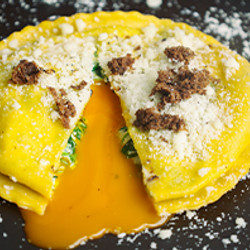For the filling:
Place 4 tbsp EVOO in a pan over medium high heat and add in the fresh spinach. Cook spinach for a few minutes until wilted and shrunk considerably, stirring occasionally.
Transfer cooked spinach into a small bowl to let it cool down.
In a different bowl, place ricotta and break it up with a fork.
Add 3 tbsp pecorino romano cheese to the ricotta and mix it through.
Add the spinach into the cheese mixture and combine this through too. The spinach should be fully covered in cheese.
Grate some nutmeg into the spinach and cheese mixture, adding as much (or as little) as you want.
Break one egg into the cheese and spinach mixture and beat well using a fork and mix this through too.
Take your piping bag and fill it with the mixture - your egg yolk ravioli filling is now ready.
Keep your bag of filling in the fridge while you make fresh pasta to keep the mixture fresh and cold.
For the fresh pasta:
Place 300 grams/7oz flour on a flat surface and make a well. The well should be as wide as possible for the eggs, but make sure the edges aren’t too thin or low because the eggs will overflow.
Break all three eggs into the middle of your flour well, using your fingers to mix the eggs without touching the flour until you can’t see the egg whites anymore.
Start to slowly add the flour. Make sure you are gentle and just add a small amount at a time.
Keep slowly mixing the egg with the flour using only one hand. Try to incorporate all the ingredients.
As the dough loosely forms, slowly knead the dough with one hand, alternating between pressing and folding the dough.
Once your dough is in roughly one piece, use both hands to knead the dough, alternating between pressing the dough forward with both hands and then rolling it back onto itself.
Once the dough is silky, smooth, and all flour is absorbed, stop kneading the dough. If your dough is too sticky, add a pinch of extra flour to your work surface.
Cover the dough with a small bowl so that it doesn’t dry out, and let it rest for 10 minutes.
To turn the dough into the ravioli:
Place a pinch of flour on your work-surface and pasta machine, so the pasta does not get stuck on the machine.
Cut ¼ of the dough using a knife, then put the small piece of dough on your floured work surface and press down on it, starting to flatten and spread it out.
Place the long side of your piece of dough into the machine on its widest setting.
Carefully roll the pasta through, then once it comes out, fold it in half, and run it through the machine once more.
Make your machine one setting thinner and repeat the process. If your dough gets too sticky, add a little flour.
Continue running the pasta through the machine and folding it in half. Do this twice on each setting, slowly working your way down the settings.
Place the long sheet of pasta on your floured work surface and cover with a kitchen towel to prevent drying.
Cut another piece of dough and repeat steps 21-26 until you have turned all your dough into sheets. You can sprinkle some flour on the top of your sheets and rest them on top of each other, covered with a towel.
To fill the Ravioli:
Once all sheets are made, take two sheets out and place them on a floured work surface.
Line up the first two sheets and remove the ends so that you have two even rectangles
Remove your piping bag from the fridge and cut the tip off to allow for easy piping.
Pipe the ricotta mix in three evenly spaced large circles on one sheet, leaving a few finger’s width borders on the edges. Fill in the circles with the mixture, but leave enough space for one egg yolk.
Separate the egg yolk from the white and place it in the space in the center of your circles of filling. Use one egg yolk per portion of filling.
If using black truffle, grate a generous amount on top of the yolks.
Dip two fingers into a bowl of water and lightly rub your fingers on the borders left on the pasta sheet around your filling circles.
Place the other reserved pasta sheet on top and gently press the edges to get all the air out.
Use a pasta cutter or tool to cut a circle around your ravioli, leaving some space around the filling and carefully peel away the excess pasta.
Use a spatula to very carefully lift the ravioli and place them on a baking sheet lined with parchment/baking paper.
Repeat steps 28-39 with the other two pasta sheets, placing the ravioli on the lined baking sheet.
To cook the ravioli:
Place 1 tbsp rock salt in a large pot full of boiling water.
Gently place the ravioli in and cook them for no longer than five minutes, working in batches (if necessary) to avoid crowding the pan.
Once cooked, use a slotted spoon to strain each raviolo from the water and place in the centre of a plate. Finally, your ravioli are ready to serve.
E ora si mangia, Vincenzo’s Plate….Enjoy!
